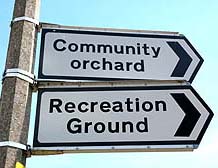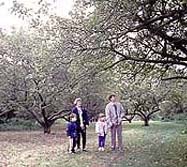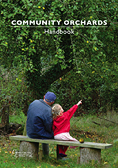![]() The Orchards Path
The Orchards Path
Community Orchards


Community Orchards offer a way of saving vulnerable old orchards and opportunities to plant new ones. They provide places for quiet contemplation or local festivities. a reservoir of local varieties of fruit and a refuge for wild life.
Orchards were once widespread throughout the British isles - apple varieties hail from north of Inverness to the edge of Cornwall. Until recently every farm, country house and suburban garden had its own collection of fruit trees.
Pressure on land for new houses and roads and the importation of cheap fruit from abroad has caused the loss of many of these small orchards. Orchards in villages and on the edge of towns are prime targets for development.
The acreage of commercial orchards has declined rapidly too. In 1970 MAFF recorded 62,200 hectares of orchards in the U.K. this declined to 46,600 hectares in 1980 and further to 22,400 hectares in 1997. This is a 64% decline in 27 years.
The main commercial fruit growing areas were, and still are Kent, Somerset, Devon, Cambridgeshire. Essex, Herefordshire and Worcestershire. Kent for eating and cooking apples, cherries, pears, plums and cob nuts, the Eastern counties for apples, the South West for cider apples, perry pears and mazzards (cherries) and the Vale of Evesham for apples, perry pears and plums. But fruit was grown extensively in other areas too - cherries in Hertfordshire, apples and cherries in Berkshire, apples in west London and so on. In fact at one time every farm and large garden would have had its own orchard of mixed fruit trees for domestic use, farm labourers often being paid partly in cider. Orchards, with their tall 'standard' trees were important landscape features.
Standard cider apples were usually spaced at 35 feet, majestic cherry trees were grown at 48 feet, and perry pears over 60 feet apart, sometimes intercropped with corn. Perry pears are long-lived trees which can have a productive life of over 300 years!
Wild and cultivated fruit trees such as damsons, bullaces, plums, cherry plums and crab apples were commonly grown in the hedgerows as linear orchards for additional crops and as wind breaks. Local preferences led to particular patterns developing such as damson hedges in Shropshire and Kent, cherry-plum in Oxfordshire and bullace in Essex.
The Need for Community Orchards
We desperately need more places to relax and play in, and we also need shared activities to enable people of different age groups and backgrounds to come together.
In city, town or village the Community Orchard is becoming the equivalent of the wood in the countryside a century and more ago - a communal asset for the whole parish. But more than that it can be the focal point for the whole village - the moot, the open-air village hall. We could have school orchards, city, museum, hospital and factory orchards open to all.
Community Orchards help to revive an interest in fruit growing, provide a way of sharing knowledge and horticultural skills and stimulate us into growing food for ourselves again.
Common Ground provide a leaflet containing advice and information on creating new community orchards, and conserving old ones. You can find out more information, and details of other orchard and apple-related publications and our series of advice notes on our PUBLICATIONS PAGES .
 Spring 2008 sees the launch of the COMMUNITY ORCHARDS HANDBOOK
Spring 2008 sees the launch of the COMMUNITY ORCHARDS HANDBOOK
2009 Saw the first COMMON GROUND SPECIAL AWARD for an apple juice or cider made by and from a Community Orchard or not-for-profit orchard.
If you have a Community Orchard, please let us know :
email info [at] commonground.org.uk
![]() What is a community orchard?
What is a community orchard?
![]() New uses for Old Orchards
New uses for Old Orchards
![]() Restoring old orchards for community use
Restoring old orchards for community use
![]() Newly planted Community Orchards
Newly planted Community Orchards
![]() What to do with the fruit.
What to do with the fruit.